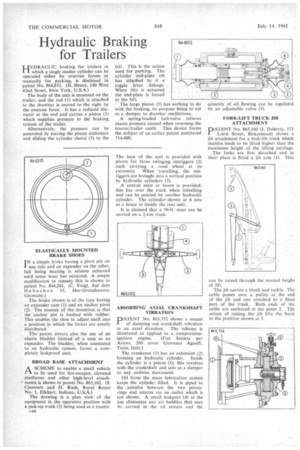Hydraulic Braking for Trailers
Page 84

If you've noticed an error in this article please click here to report it so we can fix it.
HYDRAULIC braking for trailers in which a single master cylinder can be operated either by overrun forces or manually for parking, is disclosed in patent No. 864,852. (H. Henry, 140 West 42nd Street, New York, U.S.A.)
The body of the unit is mounted on the trailer, and the rod (1) which is attached to the drawbar is moved to the right by the overrun force. It has a reduced diameter at the end and carries a piston (2) which supplies pressure to the braking system of the trailer.
Alternatively, the pressure can be generated by leaving the piston stationary and sliding the cylinder sleeve (3) to the ELASTICALLY MOUNTED BRAKE SHOES I N a simple brake having a pivot pin on one side and an expander on the other, full lining bearing is seldom achieved until some wear has occurred. A simple modification to remedy this is shown in patent No. 864,201. (C. Voigt, Auf dem Hahnchen '15, Hor-Grenzhausen, Germany.) The brake shown is of the type having an expander cam (I) and an anchor pivot (2). The essence of the invention is that the anchor pin is bushed with rubber. This• enables the shoe to adjust itself into a position in which the forces are evenly distributed.
The patent covers also the use of an elastic bladder instead of a cam as an expander. The bladder, when connected to an hydraulic system, forms a completely leakproof unit.
BROAD BASE ATTACHMENT
A SCHEME to enable a small vehicle to be used for fire-escapes, elevated platforms and other high-level attach' meats is shown in patent No. 865,102. (S. Clements and H. Rush, Rural Route No. I, Elkhart, Indiana, U.S.A.)
The drawing is a plan view of the equipment in the operative position with a pick-up truck (I) being used as a tractor.
c44
left. This is the action used for parking. The cylinder end-plate (4) has attached to it a toggle lever linkage. When this is actuated the end-plate is forced to the left.
The large piston (5) has nothing to do with the braking, its purpose being to aet as a damper to drawbar oscillations.
A spring-loaded ball-valve relieves excess pressure caused when reversing the tractor/trailer outfit. This device forms the subject of an earlier patent numbered 71.4,400.
The base of the unit is provided with pivots for three swinging outriggers (2) each carrying a road wheel at its extremity. When travelling, the outriggers are brought into a vertical position by hydraulic cylinders (3).
A central mast or boom is provided; this lies over the truck when travelling and can be erected by another hydraulic cylinder. The cylinder" shown at 4 acts as a brace to steady the rear unit.
It is claimed that a 50-ft. mast can be carried on a 1-ton truck.
ABSORBING AXIAL CRANKSH.AFT VIBRATION
PATENT No. 863,752 shows a means of damping out crankshaft vibration in an axial direction. The scheme is illustrated as applied to a .compressionignition engine. (Fiat Societa per Azioni, 200 corso Giovanni Agnelli. Turin, Italy.) The crankcase (I) has an extension (2)
forming an hydraulic cylinder. Inside the cylinder is a piston (3); this revolves with the crankshaft and acts as a damper to any endwise movement.
Oil from the main lubrication system keeps the cylinder filled. It is piped to the _annulus between the two pistonrings and returns via an outlet which is not shown. A small leakport (4) at the top eliminates any air bubbles that may be carried in the oil stream and the quantity of oil flowing can be regulated by an adjustable valve (5).
FORK-LIFT TRUCK JIB ATTACHMENT
DATENT No. 865,160 (J. Doherty, 175 Laird Street, Birkenhead) shows a jib attachment for a fork-lift truck which enables loads to be lifted higher than the maximum height of the lifting carriage. The forks are first detached and in their place is fitted a jib arm (I). This
can be raised through the normal height of lift.
The jib carries a block and tackle. The cable passes over a pulley at the end of the jib and one attached to a fixed part of the truck. Both ends or the cable are anchored at the point 2. The action of raising the jib lifts the hook to the position shown at 3.
































































































































